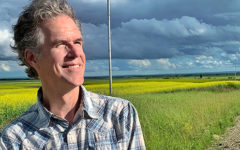
Ask Sonny Anything is a recurring feature where our readers pose questions to the great Sonny Osborne, one half of the iconic Osborne Brothers who redefined bluegrass music in the 1960s, and noted banjo maven and collector of fine prewar instruments. Everyone is encouraged to pose queries of your own each week in the comments, about his history in the music, his wealth of banjo knowledge, or regarding any life advice you might be needing.
As this is the one year anniversary of Sonny’s column, we want to start off with a query from the biggest banjo celebrity in today’s world, actor, comedian, writer, and banjo player Steve Martin.
“What are the worst circumstances you ever played under?
Steve Martin
Steve….welcome in to our shin dig. Reminds me sometimes of Lavonia, Georgia, or Columbus, Ohio. The good times.
The worst circumstances. There were several that I would think twice before going there again. Now, I have a choice… then I didn’t.
1. Winter of 1953 – We were working in Knoxville, TN for Cas Walker, since November 6. Bobby was 22 (just released from the Marine Corp and back from Korea), I was 16. Downtown Knoxville, flatbed truck bed, 25 degrees, snowing hard, 1 week before Christmas. When Cas said play, you play or go…. in this case we had to play or we wouldn’t get our $25 that week. But Lord, it was cold. My right hand was numb, I couldn’t feel the picks, trying to play the banjo and it had a skin head. Enos Johnson and L.E. White were there with Bobby and I. Thirty of the coldest minutes known to man.
2. November 1955 – Quebec Canada, snowing for a week, we had been playing every night for that week, no crowds, Not enough gas in the car to get back to Wheeling….Stress 101….5 PM…Kids were playing Hockey in the street. 7 PM a few people started to gather. 7:30…No one showed up to open the building, we needed every penny to buy gas…Food? What’s that? We needed gas for the hungry car. Top priority.. I found a window unlocked which I opened, climbed in and with a flash light found a light switch, unlocked and opened the front door, stood there and collected $490… did our show, people were happy, we were ecstatic, they loaded the car, while I locked the front door, locked the back door, turned off the lights, climbed back out the window, went back to Wheeling…still broke, but lived in the USA to play another day.
3. Presque Isle, Maine – Summertime 1968. Bobby, Dale Sledd, Ronnie Reno, and I (that’s me of course, how else would I know…DUH). We go on stage at the fairgrounds with over 5000 people in the bleachers. By our 3rd or 4th song the large, unhappy crowd had thinned down considerably. They left in droves of 20-50 each…’twas a mass exodus. There might have been 200-300 diehards remaining. Man, we didn’t even want to look at one another. Embarrassed, there must be another word, I know what that word is too, but it is not appropriate in mixed company. We felt better after I went to the office and collected our dough. I found out they had advertised us as The Osmond Brothers. I can just hear the conversation between a couple old ladies…”Which one is Marie?”
Steve, this probably doesn’t answer your question but these were a few of the trying times which makes one appreciate the good ones, and also makes one realize that there must, simply must be a higher power.
s
—–
Hi Sonny. Sure Fire is one of my favorite tunes. Can you tell us how that one came about? All the best, Chuck.
Chuck V.
Chuck, come on in here…Thank you for your time. It’s appreciated you know. Sure Fire is a mandolin tune written by my brother Bobby. The Wilburn Brothers, Doyle, Teddy, Leslie, and Lester are the people responsible for quite a lot of the successful paths we took which brought us to this town and being able to further our career playing the music we grew up around. And not to mention a membership in the Greatest show in the history of Country/Bluegrass Music…The Grand Ole Opry…back when that membership really meant something.
I mention all of the above to get to the point that the Wilburns owned a publishing Company with the name of Sure-Fire Music. We recorded many of the songs Teddy found for us, and Bobby wrote several too, all which were published by Sure-Fire… One being an instrumental with the name of Sure Fire. Great tune played by close to 100% of all mandolin players.
s
—–
Ok, I’ll bite. Tell us about the great con job of the recording industry. Truly enjoy your music and have been a fan as long as I can remember. Thanks for giving us an inside view. Your music has always been the best.
Larry Stahl
Larry, I don’t want to do this, but it says ask me anything. I do appreciate your time and I thank you.
1959. We realized that we HAD to have a good record deal and The Grand Ole Opry. The Wilburn Brothers seemed to be the most probable to get that done for us.
Fast forward to Doyle Wilburn’s office, Nashville, April of 1963. Doyle is on the phone with Owen Bradley, head of Decca records in Nashville. He is telling Owen that we are good and Chet Adkins is going to sign us on RCA this afternoon. Owen can get us for Decca if he’ll do it NOW.
Owen says No. We’re devastated.
Yes, we had been to Chet at RCA and he turned us down flat. Doyle says not to worry, he’s not done yet. He puts a call in to New York, the absolute head guy of Decca (seems like I remember his name as Sid). Doyle tells him the same story and that Owen has turned us down, and Decca would be losing a good group to RCA if he didn’t do something right them. And he closed that with “Have I ever steered you wrong?” He hung up and Doyle looked at us Bobby, Benny Birchfield and I and just smiled and winked. He said, “Owen will call in about 10 minutes.”
I will swear to this as truth. Under 10 minutes his secretary opened the door and said…”Mr. Bradley is on Line 5.” Doyle picked up and said “Owen, how you doin’?” “Yeah, They’re still here….sure, we’ll be right over.”
So, all this happened within a period of 45-60 minutes and we signed the first of 13 one year contracts with Decca.
We told Doyle we needed the Opry and he promised that in 18 months. 13 months later, late July 1964 we were members of the aforementioned Grand Ole Opry. Wilburns were a powerful bunch mid ’50s throughout the ’60s . s
—–
Hi Sonny, It’s always so good to read your posts at Banjo Hangout and on Bluegrass Today. I have Chief MP-13 built in 2007, which is a good un of course. Sounds and looks awesome! Do you know how many of the MP Chiefs were made? Thanks so much!
Gary
Gary….Thanks for following Banjo Hangout and do you realize how long the Hangout thing has been going? I said that because I want to remind everyone who reads this that Terry Herd and John Lawless have endured me for one, uno, ein, year with this episode. My goodness.
Gary you asked how many Maple Chief banjos were built…I would guess probably 250-300 range. Maybe 50-75 Mahogany and Walnut. That number is a guess. I don’t want to actually get down in the floor with books and figure it out. Too hard to get up. It was all fun though. June 16 will be 22 years. And I didn’t spend one cent advertising the Chief banjo. I wanted them to sell themselves and they did. I didn’t want to be in the banjo building business, just make a professional quality banjo, reasonable price. I did that. Only a few banjo companies left…reason… folks started building they own…(they comes from Raymond Huffmaster.) That’s my opinion.
s
—–
Kirk and Kate Schaumannk wanted to know about Jim Mills’ Old Banjo Seminar. I’m sorry to say I don’t know that but I will try to get your interest known to Jimmy and perhaps he’ll follow through.
s
Ask Sonny Anything is a recurring feature where our readers pose questions to the great Sonny Osborne, one half of the iconic Osborne Brothers








